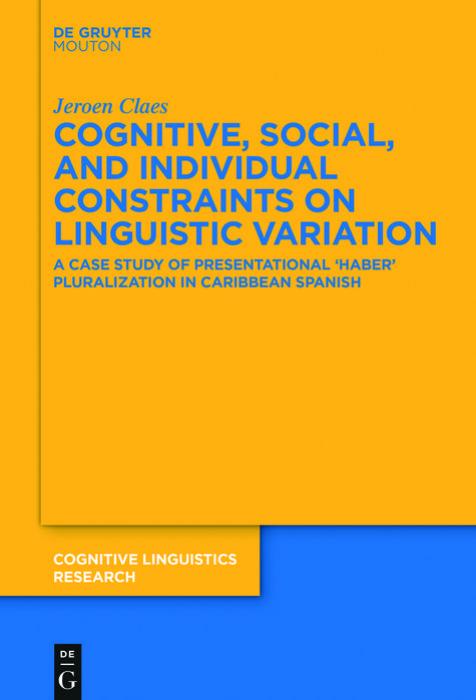Cognitive, Social, and Individual Constraints on Linguistic Variation by Jeroen Claes

Author:Jeroen Claes
Language: eng
Format: epub, pdf
Publisher: De Gruyter
Published: 2016-03-15T00:00:00+00:00
6.4Implicit nominal arguments and adverbial phrases
As noted in Section 2.1 the POINTING-OUT Idealized Cognitive Model implies that without proper context, the noun phrase argument cannot remain implicit, as it carries virtually the entire conceptual import of the clause (Goldberg 2005a: 29, 2005b: 232). Nevertheless, under specific discourse conditions, it need not be made explicit again. As observed in Section 2.1.2, in my corpus this is especially common for indefinite noun phrases that introduce hearer-new tokens of hearer-old types, as shown in example (113).
(113) Participant: Niños en la calle, yo creo.
Interviewer: ¿Antes no?
Participant: Hay más.
Interviewer: ¿No habían tantos?
Participant: Habían, siempre han habido (SD19M12/RD2513-RD2514).
Participant: ‘Children on the streets, I think.’
Interviewer: ‘Before not?’
Participant: ‘There are more.’
Interviewer: ‘There weren’t as many?’
Participant: ‘There were, there have always been.’
Similarly, the fact that the adverbial phrase is profiled and sets up a mental space in which presentational haber locates the referent of the noun phrase implies that the adverbial can only be omitted felicitously when it is recoverable (Goldberg 1995: 58–59, 2006a: 39), that is, when it refers to the base space or a previously evoked mental space. Isolated examples such as (114) and (115), which leave us wondering against which setting we have to interpret the utterances, suggest that this is the case.
(114) Podrían haber días en que yo tenía dos horas libres entremedio (SJ13H11/SJ1566).
‘There could bePL days that I had two hours of free time in between.’
(115) Claro, sí hubo muertos (SD20H12/RD2682).
‘Of course, yes, there was casualties.’
In contrast, examples such as (116) and (117) are conceptually complete, because they locate the referent of the noun phrase in the current base space. Let us now resume the most important results of this chapter.
(116) Habrán gentes que lo hagan (SD05H11/RD594).
‘There will bePL people that do it.’
(117) El racismo muchas veces viene porque muchos blancos ignoran de que hay blancos que s, negros que son tesoros (SD05H11/RD562).
‘Often, racisms comes because many whites are unaware that there is whites that a, blacks that are treasures.’
Download
Cognitive, Social, and Individual Constraints on Linguistic Variation by Jeroen Claes.pdf
This site does not store any files on its server. We only index and link to content provided by other sites. Please contact the content providers to delete copyright contents if any and email us, we'll remove relevant links or contents immediately.
| Anthropology | Archaeology |
| Philosophy | Politics & Government |
| Social Sciences | Sociology |
| Women's Studies |
Cecilia; Or, Memoirs of an Heiress — Volume 1 by Fanny Burney(32434)
Cecilia; Or, Memoirs of an Heiress — Volume 2 by Fanny Burney(31871)
Cecilia; Or, Memoirs of an Heiress — Volume 3 by Fanny Burney(31854)
The Great Music City by Andrea Baker(31349)
We're Going to Need More Wine by Gabrielle Union(18967)
All the Missing Girls by Megan Miranda(15572)
Pimp by Iceberg Slim(14394)
Bombshells: Glamour Girls of a Lifetime by Sullivan Steve(13973)
Talking to Strangers by Malcolm Gladwell(13222)
Norse Mythology by Gaiman Neil(13207)
Fifty Shades Freed by E L James(13157)
For the Love of Europe by Rick Steves(12998)
Mindhunter: Inside the FBI's Elite Serial Crime Unit by John E. Douglas & Mark Olshaker(9201)
Crazy Rich Asians by Kevin Kwan(9167)
The Lost Art of Listening by Michael P. Nichols(7406)
Enlightenment Now: The Case for Reason, Science, Humanism, and Progress by Steven Pinker(7235)
The Four Agreements by Don Miguel Ruiz(6631)
Bad Blood by John Carreyrou(6552)
Weapons of Math Destruction by Cathy O'Neil(6146)
